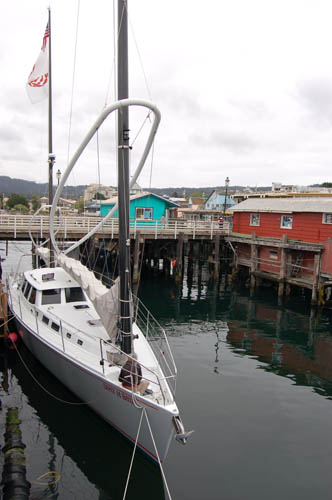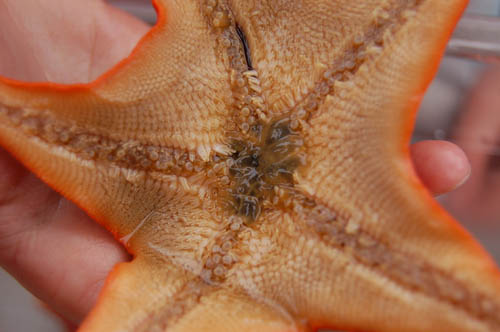If you're wondering how I've been spending my summer, I think pictures would best illustrate what I've been doing four out of five days during the week:

The Derek M. Baylis is designed to be a research vessel, and a lot of thought went into its design to maximize workspace and to make it a model for all other research and educational vessels.
Among some of the notable features, the Baylis sports a wishbone boom (click here to read more about how the sailing mechanics work using a wishbone boom) and a motor that runs on a bio-diesel blend that "sips" gas. What is a wishbone boom and how is it different from a conventional one? The best explanation that I've heard is that a conventional boom is to a wishbone boom as a stick shift is to an automatic. The rig self-regulates the shape of the sail since it is suspended and not fixed to one point on the mast.
For more information on the Baylis, as well as Tom Wylie's other cool designs, check out this link:
Wyliecat Performance Yachts: Wyliecat 65
Monterey Bay Aquarium and Sealife Conservation run educational and leisure cruises in a joint venture. The aquarium provides the naturalists (of whom I am one) and sells tickets, while Sealife Conservation provides the crew and the boat.
I usually start my day below the docks, picking up the clipboard that holds the ship's manifest. As you can tell, all of the male California sea lions are coming back from their summer down south in the Channel Islands, where they were busy mating. It's amazing how quickly they've returned, and how valuable real estate has become around the harbor.
Over 90 percent of the sea lions up here are males. The females prefer the warmer waters down south. As one visitor put it, Monterey Harbor sounds like a big frat house because of all of the noise and displays of dominance among the male sea lions.
Giant kelp is the foundation of the ecosystem along the California coastline. It serves as a nursery, a food source, a place to hide, or a place to hold on to for countless organisms. On a piece of drift kelp that we pulled up today, we found polychaete worms, kellet's whelks, bryzoans, melibes, small shrimp, isopods, amphipods, a baby sea urchin, fish fry, decorator crabs, and kelp crabs. This was a spectacular haul and a great illustration that kelp is some really cool stuff.
Kelp crabs are good at letting you know that they don't want anything to do with you. Their pincers are sharp like needles, and painful if they catch your fingers. They make searching through kelp interesting for those willing to paw through the slimy kelp.
Anyone for paralytic shellfish poisoning? That's what you might get if you drank from the codpiece of our plankton net this afternoon (By the way, codpiece refers to the portion of the net where the plankton is concentrated, as the design was taken from a cod fishing nets and that's where the cods ended up. It is not, as I originally though, named after ye Medieval jockstrap.). The plankton that we've been pulling up have mostly turned the net a brownish green, but today it was red with dinoflagellates. Besides causing the red tide when they bloom, they are also responsible for phosphorescense.
I heard the following story from someone who works at the aquarium:
During WWII, the GIs in the Pacific learned that Japanese snipers used to target those using flashlights at night. At night time, some soldiers used their cotton shirts to sieve dinoflagellates out of the water, and allowed them to dry into a powder. By taking a pinch of the dehydrated dinoflagellates, they were able to read their maps with the faint blue light produced by smashing it between their fingers and avoid the snipers, who were looking for the yellow light produced by the flashlights.
So thanks partly to plankton, the Allies were able to achieve victory in the Pacific Theatre...
In addition, phytoplankton produces an over 60 percent of the Earth's oxygen and is the basis of the food web in the ocean. It sequesters CO2 as CaCO3 (chalk), and layers of fossilized plankton give us SiO2 rich deposits as well, which we use to filter out our swimming pools (salacious earth).
Plankton is some pretty cool stuff.

If you drop a crab trap, or "benthic sampler" (there are many designs, my favorite being a clamshell design that traps mud from the sea floor), down to the bottom of the outer edge of the kelp forest, most of what you pull up is likely to be batstars. This one has it's stomach out. You may recall that starfish eat by bringing their digestive system to their food. They hug whatever they are eating with their stomach, in other words.
Some other cool facts about batstars:
The orange ones range down to Mexico and the purple ones up to Alaska, and they meet in Monterey.
They often host symbiotic polychaete worms which clean the batstars of food scraps and parasites.
Predators of batstars include, but are not necessarily limited to sea gulls, sea otters, and other larger species of starfish.
They can easily regenerate an arm if they happen to lose one.
Batstars are echinoderms, related to things like sand dollars, sea urchins, and sea cucumbers. If you look at echinoderms, they all have a pattern of five points radiating from the center.
Some batstars have up to seven arms, and at each tip of each arm is a primitive eyespot, with which they can sense the presence or absence of light.
When the sails are raised, the boat starts to really show off how well it handles. We routinely hit 10 knots with a reefed main sail, without the help of the mizzen (the smaller sail in the back of the boat). Since the boom is so high, the foredeck is a pretty safe and comfortable place to enjoy the cruise. When it's time to put away the sail, the halyard is released and the sail quickly drops into the hammock below in a matter of seconds.
This is a shot of Monterey Bay Aquarium in the foreground, looking down the length of Cannery Row. We stick to this area in the bay, as it provides a relatively sheltered patch of water, and a great view of the coastline. In this patch of coastline I've seen Humpbacks, Grey whales, Common Dolphins, Risso's Dolphins, Pacific White-sided Dolphins, Harbor Porpoises, California Sea Lions, Southern Sea Otters, and Harbor Seals.
200 years ago, there were grizzly bears feasting on whale carcases, and 300 years ago there used to be a giant sea cow, the Steller's sea cow, that munched on the giant kelp. After the sea otters were almost hunted to extinction, there were long periods of time where the kelp disappeared from the coastline. Only after otters started to re-populate the coast did the kelp forests return and stabilize.
By telling these stories, making ecological connections, and facilitating discussions, we are able to really educate and inspire those who come along for a ride on the Baylis.
